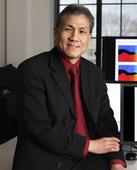The 2015 AMMCS-CAIMS Congress
Interdisciplinary AMMCS Conference Series
Waterloo, Ontario, Canada | June 7-12, 2015AMMCS-CAIMS 2015 Plenary Talk
Multiscale Modeling of Soft Materials and Related Biological Responses
Wing Kam Liu (Northwestern University)
Liquids, polymers, gels, foams and a number of biological materials are soft
materials, which can be easily deformed by thermal stress or thermal
fluctuations. Predominate physical behaviors of these soft materials occur at
energy scale comparable with room temperature thermal energy. These behaviors
cannot be, or are not easily, to be directly predicted from its atomic or
molecular constituents. This is because the soft materials are always
self-assemble into mesoscopic structures, which are much larger than the
microscopic scale, and yet much smaller than the macroscopic scale of these
materials. Especially, the mechanical and physical properties of soft materials
originate from the interplay of phenomena at different spatial and temporal
scales. As such, it is necessary to adopt multiscale methods when dealing with
soft materials in order to account for all important mechanisms. The offerings
of this lecture are twofold: (1) establishing a multiscale modeling framework
to predict viscoelastic behaviors of polymers through fractional derivatives,
(2) rapid computational prototyping and testing of drug carriers in tumor
microvasculature through immersed molecular finite element method (IMFEM). In
(1), we have incorporated the fractional diffusion of free chains into the
integration kernel for the viscoelastic response of polymers and polymer
nanocomposites using the Mittag-Leffler function. While conventional models for
viscoelastic materials employ a discrete relaxation spectrum, the
fractional-order model exhibits a continuous relaxation distribution, which is
in accordance with experimental observations. In (2), the IMFEM is used to
simulate the whole blood including blood plasma, red blood cells and
nanoparticles. We elucidate how the size, shape and stiffness of nanoparticles
will affect their dispersions in the microvasculature, with the accurate
molecular interactions informed by molecular mean-field theory.

Dr. Wing Kam Liu, Walter P. Murphy Professor of Northwestern University, has
made fundamental, innovative contributions to the theory, methodologies, and
applications of multiscale simulations towards the understanding and design of
nano-materials, polymers science, and multiresolution mechanics. His ISI and
Google citations and H factors are (14,200, 60) and (37,750, 88), respectively.
In 2014, Liu is selected as a highly cited researcher in Computer Science and a
member of the World’s Most Influential Scientific Minds by Thompson Reuters.
Liu developed new exceptional accuracy meshfree methods for simulation of
extremely deformation of solids and fluids including additive manufacturing;
fractional-order viscoelasticity polymer science; fluid-structure interaction,
and applicable to medical imaging. He was the PI of a multi-year multi-million
research grant from Goodyear Tire and Rubber Company to develop and integrated
design strategy to enable prediction, synthesis and characterization of new
polymer nanocomposites to achieve enhanced performance. Liu is current the
President of IACM and Chair of USNCTAM; Founding Director of the Summer
Institute on Nano Mechanics and Materials; Founding Chair of the ASME
NanoEngineering Council; Editors of Computational Mechanics & Int. J. of
Applied Mathematics and Mechanics; Honorary Editor of Int. J. of Computational
Methods; serve on numerous editorial boards; Consultant to 20+ organizations.
Liu has written three books; and he is a Fellow of ASME, ASCE, USACM, AAM, and
IACM. Liu’s selected awards and honors including: 2014 Japan Society for
Computational Engineering and Science Grand Prize in recognition of his
outstanding contributions in the field of computational mechanics; the Honorary
Professorship from Dalian University of Technology in 2013; the 2012 IACM
Gauss-Newton Medal; the 2012 ASME Design Automation Conference Best Paper
Award; the 2009 ASME Dedicated Service Award, the 2007 ASME Robert Henry
Thurston Lecture Award, the 2007 USACM John von Neumann Medal, the 2004 JSME
Computational Mechanics Award, the 2002 IACM Computational Mechanics Award, the
2001 USACM Computational Structural Mechanics Award, the 1995 ASME Gustus L.
Larson Memorial Award, the 1985 ASME Pi Tau Sigma Gold Medal, the 1979 ASME
Melville Medal, the 1989 Thomas J. Jaeger Prize of the ISMIRT, and the 1983
Ralph R. Teetor Educational Award, American Society of Automotive Engineers.